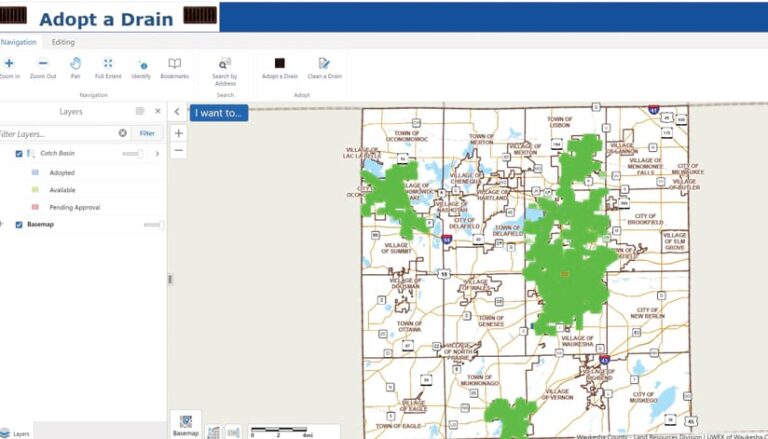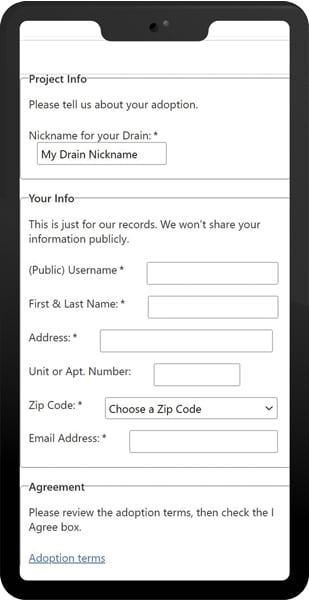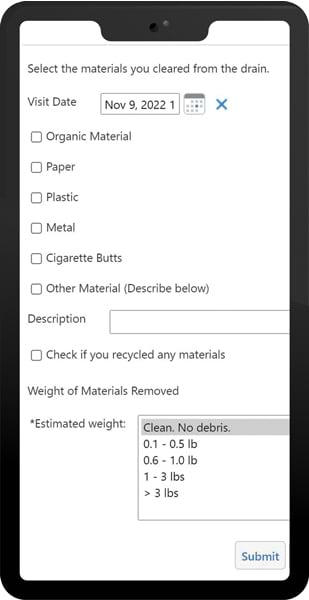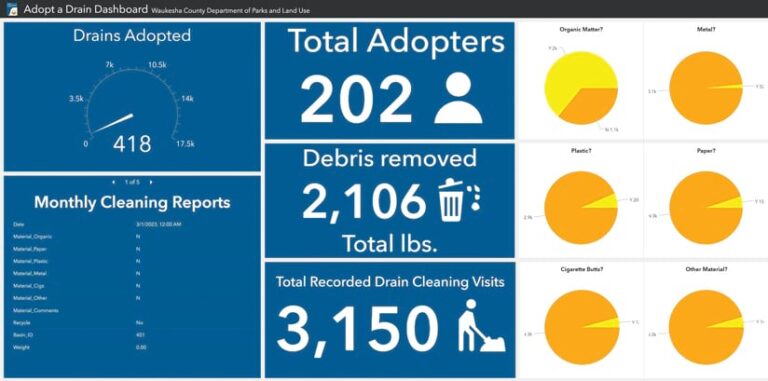In January 2018, Jayne Jenks, a conservation specialist with the Waukesha County, Wisconsin, Land Resources Division, approached the county’s land information systems team about using GIS to help develop an adopt-a-drain program. The program would allow county residents to choose a storm drain near their homes to keep free from debris. The idea was to give residents a sense of ownership over a small part of their stormwater infrastructure, resulting in greater community stewardship of the county’s waterways.

The adopt-a-drain program had two goals. First, the county wanted to improve the quality of water in regional waterways by reducing the flow of trash, debris, plastics, and organic matter into the stormwater system, which drains directly into local rivers, streams, lakes, and ponds. By encouraging residents to keep drains clear of detritus, the county would be able to naturally improve the area’s water quality.
Second, Waukesha County aimed to reduce the number of storm drains that get backed up during heavy rainfall. If left unchecked in a deluge, storm drains can become clogged with organic matter and trash, causing stormwater to pool in intersections and creating traffic hazards and other issues. With the recent increase of strong storms and 100-year flood events in the region, it is critical that stormwater runoff systems work at peak efficiency to quickly move water downstream or into retention ponds.
Jenks wanted the adopt-a-drain system to be easy for residents to use; supply the county with key metrics, such as which drains have been adopted and how much waste gets cleared from them; and inform future actions that cities and the county could take to ensure good water quality throughout the region. Relying on Waukesha County’s already existing ArcGIS Enterprise deployment, along with technology from Esri partner VertiGIS and a dashboard built with ArcGIS Dashboards, Jenks and Jim Landwehr, the supervisor of Waukesha County’s land information systems team, created an adopt-a-drain program that’s proving popular with residents and a good example for other local government organizations.

A Data-Rich App Achieves Several Goals
From a geographic standpoint, Jenks decided to start small with the adopt-a-drain program by developing a pilot project in a single city. She wanted to see if residents would embrace the initiative and give the county a chance to work out any issues before broadening it to other areas.
The city of Waukesha was chosen as the pilot area—in part because it has a mature GIS, including a complete and spatially accurate inventory of storm drain assets, and in part because the city and Waukesha County have a long history of collaborating with GIS. They share data, work together on parcel mapping, and jointly participate in the Southeastern Wisconsin Esri Technical Users Group.
To get residents of the city of Waukesha (and eventually the whole county) involved with the program, Jenks wanted to develop a public-facing web app. She thought it should have a simple, map-based interface that would allow users to easily find and select drains to adopt before entering a minimal amount of address data that the county would use to mail them an adoption kit. The kit includes instructions for how to clear a drain, an adhesive storm drain sign that reminds people that these catch basins drain into local waterways, and a reflective vest to wear when cleaning a drain in high-traffic areas.
Landwehr designed the app using Geocortex Essentials from VertiGIS. The product’s Workflow Designer allowed him to develop custom forms that prompt users for information and carry out related tasks based on their responses. The web app is powered by feature services in ArcGIS Enterprise that display storm drain locations on a map. Editing tools within the app’s interface enable users to select a drain to adopt and enter their contact details so that the county can mail them educational materials and small promotional rewards if they become frequent cleaners.
The drain adoption form also allows users to have a little fun by giving their chosen drain a nickname. This has resulted in drains throughout the city of Waukesha acquiring creative monikers, including Drainy McDrainface, Clown Lookout, Purple Drain, and Drain Dead Easy. In addition, the form ensures that drain adopters acknowledge and accept the terms of agreement that absolve the county of liability.

Once residents start cleaning their drains, the app allows them to record data about their drain visits, including the type and estimated weight of the materials they remove. This data collection feature is what makes Waukesha’s adopt-a-drain program a little different from standard asset adoption programs in which participants simply choose a piece of infrastructure to keep clean and the government-resident interaction ends there. The debris statistics that drain adopters submit through the app help Waukesha County’s Land Resources Division understand the general composition of materials that find their way into these inlets. Users can also check a box to indicate whether they recycled any recyclable materials after removing them from the drain.
To help county staff members and the public monitor the drain adoption program and related cleaning statistics, Jenks asked Landwehr to create a public-facing dashboard. He used ArcGIS Dashboards to build a dashboard that presents the information in easy-to-interpret charts, graphs, and information boxes. The dashboard includes specifics on what types of materials drain adopters collect, which provides Land Resources Division staff with data to support cleanup priorities and develop targeted educational campaigns.
Success with Residents and Beyond
As of March 2023, more than 200 residents of Waukesha County have adopted nearly 420 storm drains. Those stewards have paid more than 3,100 visits to their drains to inspect and clean them and have removed an estimated 2,100 pounds of debris from the local stormwater system. County staff have received some great feedback from residents as well.
“Helping to keep the Fox River clean by removing debris from the drains is very rewarding,” said one Waukesha resident named Susan. “I find that if I clean the drains right after either a wind or rainstorm, I am likely to find organic matter that would otherwise go straight into the river. It isn’t often that you find something that takes only a few minutes per month with such immediate impact!”
Another resident, named Josh, said that his nephew took an interest in helping clear drains over the summer. “Every time he’s visited since, he always tells his dad to drive slowly as they enter the neighborhood so that he can scope out the status of the drains,” Josh wrote.
After the pilot project in the city of Waukesha showed success, the county broadened the geographic extent of the adopt-a-drain program to five other communities, including the cities of Pewaukee and Oconomowoc and the villages of Mukwonago, Pewaukee, and Sussex. Two additional communities are slated to join the program in 2023, and eventually residents will be able to adopt stormwater drains all over urban areas of the county.

Waukesha County’s adopt-a-drain initiative also caught the attention of the Dane County Land Information Office, located in Wisconsin’s state capital, Madison. The GIS team there sought advice from Waukesha County staff on the functionality, back-end development, and rollout of the web app. Dane County has since introduced a similar program to its residents, since it is evident that people will take action if asked and given the right tools.
As Waukesha County continues to urbanize, efforts to keep its waterways, parks, and natural areas clean need to keep pace. While encouraging residents to adopt storm drains might seem like a small undertaking for a large problem, it is an attempt to empower people to take more responsibility for their surroundings by becoming environmental stewards. It is through programs like this—along with the Waukesha County Recycle Right and adopt-a-trail initiatives—that small changes can lead to big solutions.
Over the years, staff in Waukesha County’s Land Resources Division have realized that GIS technology can be used for education, mitigation, and collaboration to help keep the natural environment healthy. With that comes the realization that GIS is making Waukesha County a better place to live and play.
For more information on Waukesha County’s adopt-a-drain program or web app, email Landwehr at jlandwehr@waukeshacounty.gov.

